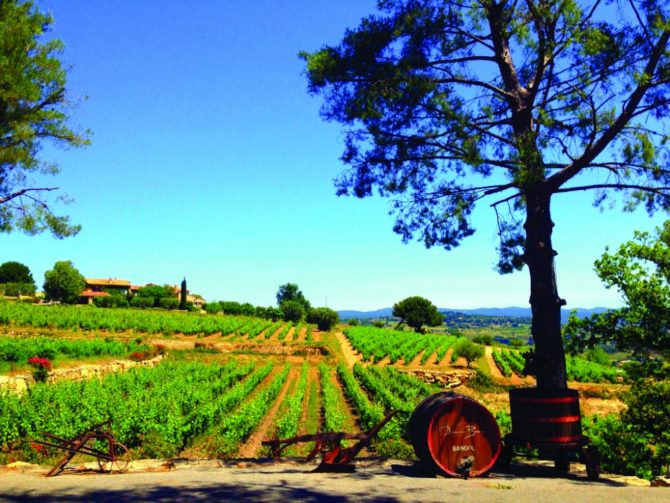Bandol’s Wines: Provence’s True Star

Henri nearly reels backwards as the weight of the basket on his back pulls him earthbound. A few clusters of dark ruby grapes fall to the rocky soil beneath and burst. Immediately, the late-afternoon heat sends wafts of violet, black pepper and thyme to greet us. We look down to the azure sea below, its salty breezes gathering force as the day closes and both agree that to tumble down into the embrace of such a cool and refreshing end wouldn’t be the worst fate.
As we continue our travail on the steep, rugged Provençal hillside, I hear Henri murmur that, “there is no other place like here”.
So many things make the Provençal commune of Bandol a unique place: its micro-climate, use of Mourvèdre as its primary varietal, steep slopes requiring manual harvests and a pure pedigree as an ancient wine-making region.
Bandol is one of the eight Provençal appellations. AOC Côtes de Provence seems to get all of the attention – apart from Bordeaux, it’s the only other region in France that has its own classified growth ranking. Burgundy, Champagne, Alsace and the Loire, for example, all classify their vineyards by area and not by château or estate.
You have to love that chutzpah. And it is merited. But for those who venture outside of this appellation – to Cassis, Bellet, Palette or Bandol – rich rewards await.
In this writer’s opinion, Bandol is the star of what is a very long-running show. The Phoenicians were making wine in Bandol 2,500 years ago, before the Romans moved in, and its produce enjoyed the favour of the French courts when Bordeaux was still a swampy marshland.
The AOC Bandol, created in 1941, comprises about 1,555 hectares, sprinkled throughout the hillsides behind the fishing port that gives the commune its name, and stretching along the seaside, east of Marseilles and west of Toulon. Nature has created a sort of natural amphitheatre, a bowl of sunshine cooled by the sea. The climate is kept temperate and there’s sufficient rain so all is in place for the optimum maturation of the grapes. The vines cling desperately to the rugged red-clay and limestone slopes and this means that mechanical harvesting is impossible, and thus, hand-gathering ensures a finer selection of grapes, in better condition and with smaller yields.
Bandol produces red and rosé wines from Mourvèdre, Cinsault, Syrah, Carignan and Grenache, and whites from Clairette Blanche, Bourboulenc and Ugni Blanc. The whites are lively, crisp and mineral, the rosés fabulously earthy and spicy, and the reds are simply the star of the show. Bandol is the only appellation in France where Mourvèdre is used as the dominant grape. It has to be at least 50 per cent of the blend. This gives us wines that are meaty, savoury, full-bodied and perfumed with leather, violet, thyme, strawberries and honeyed lavender.
The thick-skinned Mourvèdre is also perfect for the hot southern climate – in comparison, for example, Grenache suffers in heat and is planted on the cooler northern-facing slopes where possible. Bandol’s reds are wines to cellar that easily rival those from France’s classic regions.
In fact, this is what the region’s vignerons are counting on. Bandol now plays a very important role in the Provençal drama. There exists a sort of inferiority complex because of the strong association that Provence – and Bandol – has with rosés. They feel that their reds aren’t taken seriously enough and so are propelling them into the international limelight. But this crise de confiance isn’t necessary. Bandol does all three wine styles perfectly and shouldn’t change. It’s the consumers’ perception of rosé as not being a ‘serious’ wine, that needs to be modified.
These stunning wines have continued to perform throughout the millennia and long may the show go on.
For more information, visit www.vinsdebandol.com
Exploring the AOC Bandol
There are only 56 estates in Bandol, which makes getting to know this special appellation eminently achievable. The Maison de Vin de Bandol in the Place Lucien Artaud houses an Oenothèque and is the perfect place to start your gustatory journey.
A recent tasting of the Domaine’s Ott’s 2010 Château Romassin (rouge) reaffirmed my life-long passion for these wines. It is superbly balanced, fresh and mineral with a nice finish, largely in part to its correct alcohol content, 12.5 per cent ABV, thanks to that perfect micro-climate. Avoid those at 15 per cent as the alcohol masks the taste of the grapes and the soil’s influence and will bore you. This jewel, however, is peppery, savoury and reminiscent of grilled lamb chops smothered in herbs de Provence and olive oil. It’s smoky with notes of lavender and dusty old lace yet bright and personable.
Other AOC Bandol estates to enjoy – in red, white and rosé – are the inimitable Château de Pibarnon, the Domaine du Gros’Noré, the Domaine le Galatin and the Domaine La Suffrène. But frankly, it is impossible to find a poorly-made Bandol!
Linda Johnson-Bell is a US-born, French-raised, award-winning wine critic and author based in London, Oxford and Venice. To learn more about this topic, read Linda’s upcoming book, Wine and Climate Change, to be published by Burford Books, NY.
Want to discover the real Provence? Join France Today on our luxurious yet intimate tours of Provence
From France Today magazine
Share to: Facebook Twitter LinkedIn Email
Leave a reply
Your email address will not be published. Required fields are marked *




REPLY